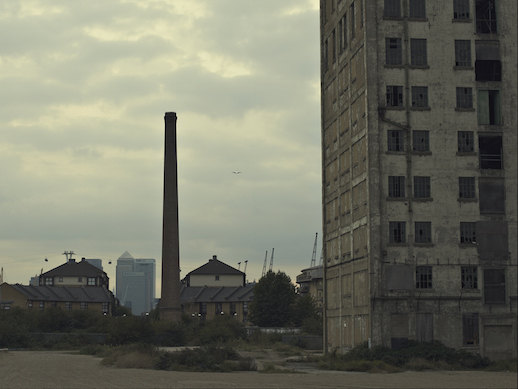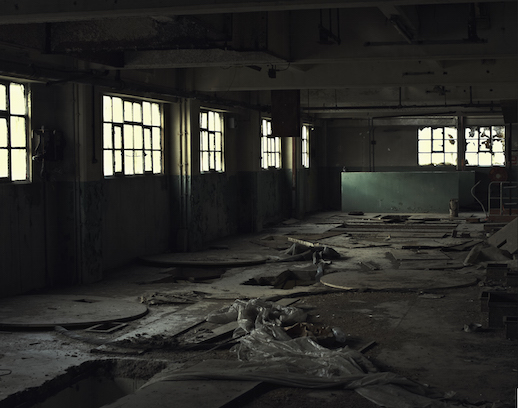Over the last 12 months, the Greater London Authority has granted Aino Tytti unrestricted access to The Millennium Mills, a vast and decaying derelict mill site in London’s docklands. Kate Carr reviews the resulting album, available now as a digital download via Touch. Photos: Aino Tytti.

If you are a careful listener, you will have noticed that buildings all sound a little different. As the Finnish architect Juhani Pallasmaa observes: “Every building or space has its characteristic sound of intimacy or monumentality, invitation or rejection, hospitality or hostility.” The echo of an empty house bares little resemblance to the sounds of a furnished home; the abandoned factory resonates differently to the functioning one.
In his majestic Millennium Mills composer and field recordist Aino Tytti is firmly focused on the resonance of empty spaces, the sounds of absence, abandonment and decay. The album is the result of 12 months spent recording in the Millennium Mills, a now derelict former flour mill located in London’s Docklands precinct, with Tytti utilising conventional mics as well as geophones, hydrophones and the rebroadcast of vocals and sine tones within the space to capture its echoes, vibrations and hidden soundscapes.
The result is an extraordinary document which, given the mills are set to be transformed into a centre for start-up businesses as part of a sweeping redevelopment, may stand as the final record of the site. Many of us are fascinated by industrial ruins. They are uncanny, deeply mysterious places; sites out of time, out of step with their surroundings. In The Aesthetics of Decay Dylan Trigg writes that one of more subversive aspects of industrial ruins is that they exist as objects ‘fallen from [their] supposed permanency’. These are failed sites, sites which have outlived their usefulness, sites which exist now only to slowly crumble away before our eyes, or so we think until one day they are shockingly gone, bulldozed in mere hours.

With track titles such as ‘England’s Last Lies Ruined’, ‘A Requiem For Silvertown’ and ‘These Halls Which Used To Breathe And Sing’, Millenium Mills is a deeply nostalgic album which leaves the listener in no doubt of Tytti’s affection for these decaying buildings, and dismay at their pending demolition. But it is also full of surprises. The opening piece ‘Observations From The Nightwatch Hut, Late November’ is all delicately vibrating tin roofs, footsteps on wooden floors and beautifully utilised snatches of walkie talkie exchanges. ‘These Halls Which Used To Breathe And Sing’ opens with the squawks of seagulls before plunging into a reverie of creaking bass, shimmering vocals and bursts of static, while ‘Silo D’ celebrates the sheer theatricality of the reverb which can be found in vast empty buildings using vocals broadcast within the silo, and a performance consisting of wonderfully startling baritone blows, and what sounds like the careful scattering of small pieces of metal.
Drones, whether derived from human voice, sine tones, or from recordings of the building itself, are central to Millennium Mills. My favourite is perhaps the most understated of them all – the deep pulsing found in ‘Waxing Gibbous Shines On The Black King’s Wharf (for Chrissie)’. This piece appears to incorporate hydrophone recordings, with their characteristic sounds of fish and aquatic insects gurgling, squeaking, buzzing and groaning. But it is the deep spectral bass drone which gives the piece its grandeur. In an interview with The Quietus Tytti revealed that he could hear the digging of the Crossrail tunnel during some of his underwater recordings, and I can’t help but wonder if this is the sound of that tunnelling as it echoes through the waters surrounding the wharf. Either way it makes for an arresting piece of audio which leads perfectly into the sheer bliss of ‘First Light, Crepuscular Loculus.’
In Acoustic Territories: Sound, Culture and Everyday Life sound theorist Brandon LaBelle discusses the ways sound is continually shaped and re-shaped as it moves through specific architectures, landscapes, buildings and geographies. In his words this characteristic of sound means it never ‘forgets’ all the surfaces, bodies and other sounds it brushes against. In Millennium Mills, part tribute, part lament, Tytti gives us a striking example of some of the compelling ways sound helps us to remember.
Listen to a preview version of Millennium Mills below: